
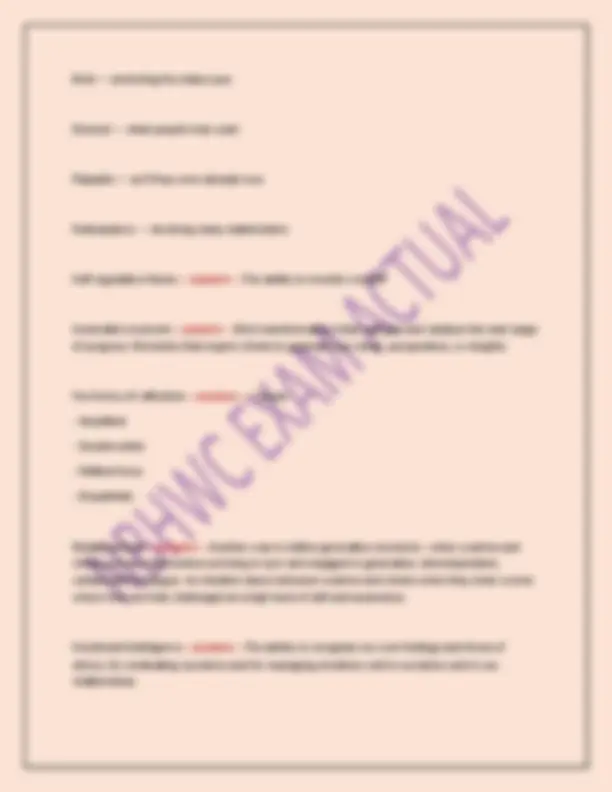
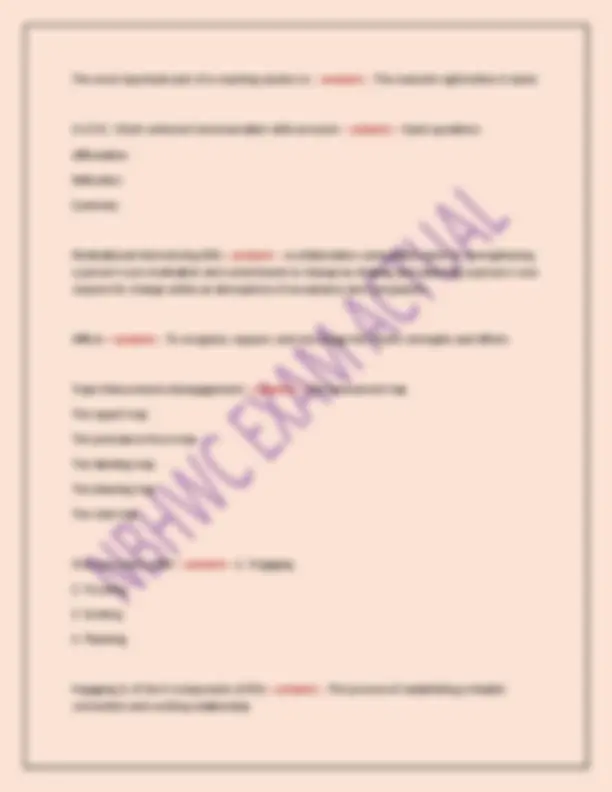



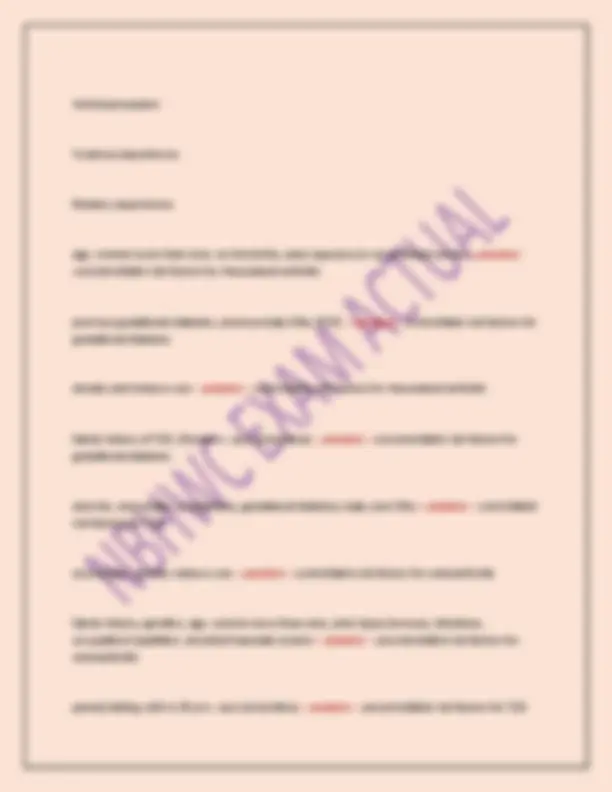
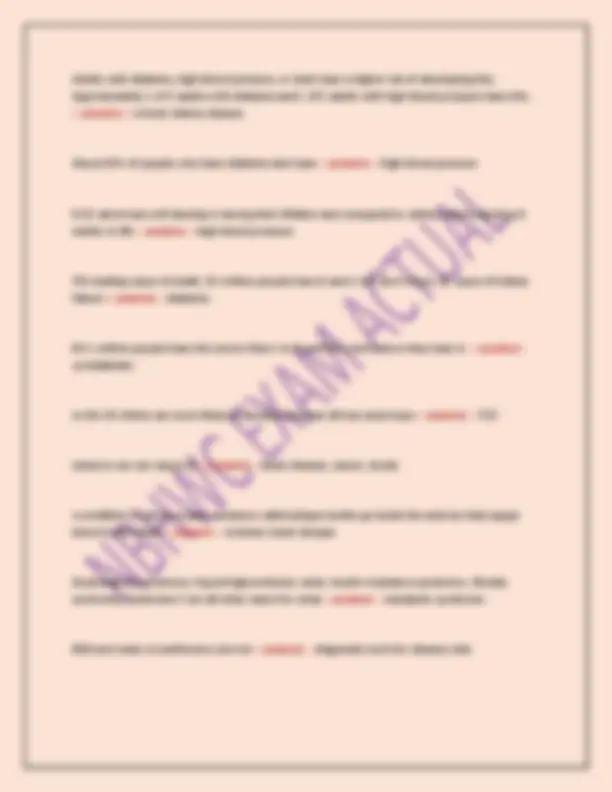
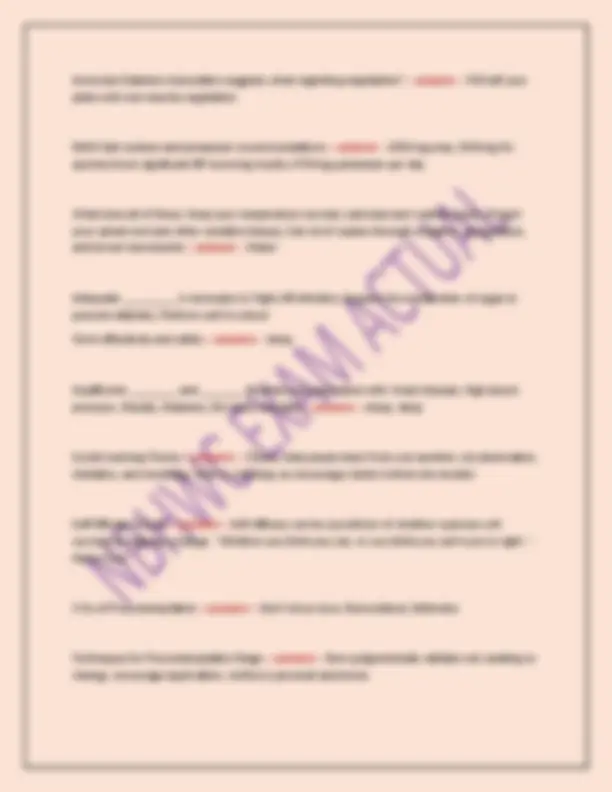
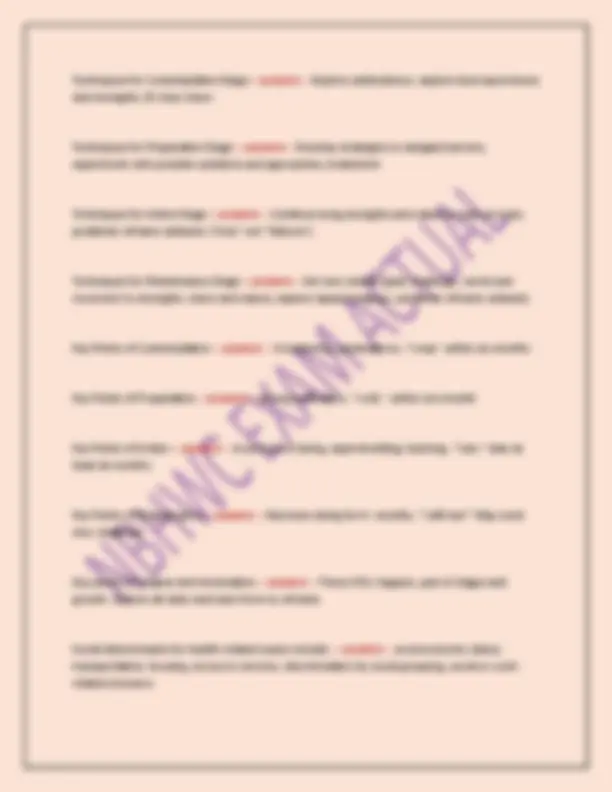


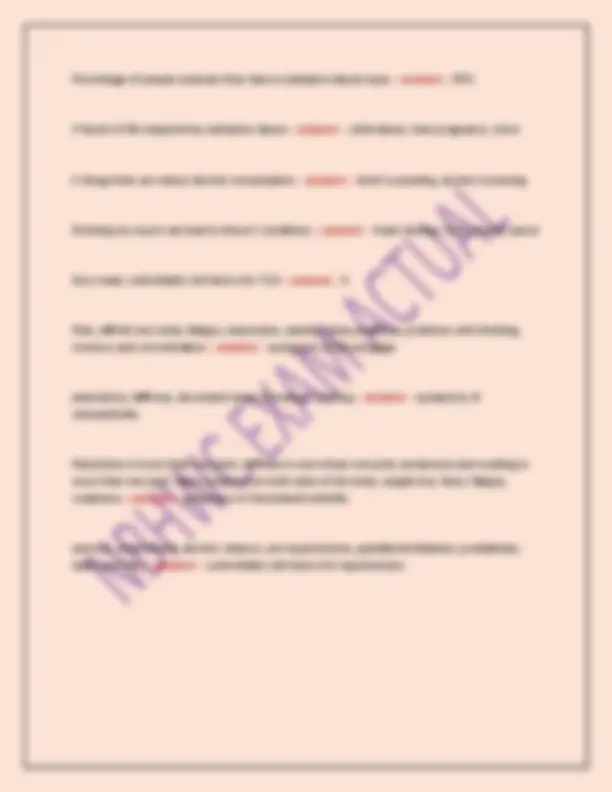


Study with the several resources on Docsity

Earn points by helping other students or get them with a premium plan


Prepare for your exams
Study with the several resources on Docsity

Earn points to download
Earn points by helping other students or get them with a premium plan
Community
Ask the community for help and clear up your study doubts
Discover the best universities in your country according to Docsity users
Free resources
Download our free guides on studying techniques, anxiety management strategies, and thesis advice from Docsity tutors
NBHWC EXAM ACTUAL EXAM QUESTIONS AND CORREC T DETAILED ANSWERS WITH RATIONALES (VERIFIED ANSWERS) |AGRADE
Typology: Exams
1 / 20

This page cannot be seen from the preview
Don't miss anything!













Self-determination (Deci & Ryan, 1985) :- answers - :A client's ability to reach his or her highest level of motivation, engagement, performance, persistence, and creativity. How often should cholesterol be checked? :- answers - :Every 5 years for young adults and 1- 2 for older adults Positive psychology (Peterson,2006) :- answers - :
Appreciative Inquiry (Cooperrider & Whitney, 2005) :- answers - :An approach for motivating change and enhancing well-being that focuses on exploring and amplifying the best in a person or situation. Nonviolent Communication (Rosenberg, 2005) :- answers - : motivational interviewing (Miller & Rollnick, 2012) :- answers - : emotional intelligence (Goldman, 1996) :- answers - : Design Thinking (Brown, 2008) :- answers - : Flow Theory (Csikszentmihalyi, 1990) :- answers - : history of OA in another part of the body, genetics, age, women more than men, race (some Asians have lower risk) :- answers - :uncontrollable risk factors for osteoarthritis what is the one controllable risk factor for osteoarthritis :- answers - :obesity Five Stages of Change :- answers - :1. Precontemplation
The most important part of a coaching session is: :- answers - :The moment right before it starts O.A.R.S. Client centered Communication skills acronym :- answers - :Open questions Affirmation Reflection Summary Motivational Interviewing (MI) :- answers - :a collaborative conversation style for strengthening a person's own motivation and commitment to change by eliciting and exploring a person's own reasons for change within an atmosphere of acceptance and compassion. Affirm :- answers - :To recognize, support, and encourage the client's strengths and efforts Traps that promote disengagement :- answers - :The assessment trap The expert trap The premature focus trap The labeling trap The blaming trap The chat trap Four processes of MI :- answers - :1. Engaging
Focusing (1 of the 4 components of MI) :- answers - :The process by which you develop and maintain a specific direction in the conversation about change Evoking (1 of the 4 components of MI) :- answers - :Eliciting the client's own motivations for change Planning (1 of the 4 components of MI) :- answers - :Developing commitment to change and formulating a concrete plan of action Spirit of MI :- answers - :Partnership Acceptance Compassion Evocation Acceptance includes :- answers - :Absolute worth (unconditional positive regard) Accurate empathy (active listening) Autonomy support Affirmation Gordon's 12 Roadblocks to Good Listening :- answers - :1. Ordering, directing, commanding
Self regulation :- answers - :The capacity to formulate a plan of one's own and implement behavior to carry it out. Agenda mapping :- answers - :A (focusing) metaconversation in which you step back with the client to choose a direction from among several options. Self determination environmental needs and supporting components :- answers - :"Universal needs":
Verbal persuasion Vicarious experiences Mastery experiences age, women more than men, no live births, early exposure to secondhand smoke :- answers - :uncontrollable risk factors for rheumatoid arthritis previous gestational diabetes, previous baby 9lbs, PCOS :- answers - :controllable risk factors for gestational diabetes obesity and tobacco use :- answers - :controllable risk factors for rheumatoid arthritis family history of T2D, 25years +, race (minorities) :- answers - :uncontrollable risk factors for gestational diabetes exercise, overweight, prediabetes, gestational diabetes, baby over 9lbs :- answers - :controllable risk factors for T2D overweight, obesity, tobacco use :- answers - :controllable risk factors for osteoarthritis family history, genetics, age, women more than men, joint injury/overuse, infections, occupation/repetition, stressful/traumatic events :- answers - :uncontrollable risk factors for osteoarthritis parent/sibling with it, 45yrs+, race (minorities) :- answers - :uncontrollable risk factors for T2D
family history, genetics, age, familia hypercholesterolemia, gender (up to 55 women have lower LDL, all ages men have lower HDL) :- answers - :uncontrollable risk factors for lipid abnormalities This condition has no controllable risk factors and only one uncontrollable risk factor which is :- answers - :fibromyalgia; age family history, genetics, women and men about the same, age, black people more that white people and develop this earlier in life :- answers - :uncontrollable risk factors for hypertension parent/sibling with T2D, 45yrs+, race (minorities) :- answers - :uncontrollable risk factors for prediabetes exercise, diet, overweight, gestational diabetes, baby over 9lbs :- answers - :controllable risk factors for prediabetes Sudden numbness/weakness in face, arm, or leg (one side); sudden confusion, difficulty speaking, understanding speech; sudden trouble seeing in one or both eyes; sudden trouble walking, dizzy, loss of balance, coordination; sudden severe headache with no known cause :- answers - :symptoms of a stroke chest pain/discomfort; weakness, lightheaded, cold sweat; pain/discomfort in arms/shoulder; shortness of breath; in women nausea :- answers - :symptoms of a heart attack family history, genetics, increased risk with age, #1 killer for african americans, hispanic/latino, american indian, AK natives :- answers - :uncontrollable risk factors for heart disease #1 and #2 killers of asian americans and pacific islanders :- answers - :1. cancer 2. heart disease
Adults with diabetes, high blood pressure, or both have a higher risk of developing this. Approximately 1 of 3 adults with diabetes and 1 of 5 adults with high blood pressure have this. :- answers - :chronic kidney disease About 60% of people who have diabetes also have :- answers - :high blood pressure 9/10 americans will develop it during their lifetime and compared to whites, blacks develop it earlier in life :- answers - :high blood pressure 7th leading cause of death, 30 million people have it and 1 in 4 don't know, #1 cause of kidney failure :- answers - :diabetes 84.1 million people have this (more than 1 in 3) and 90% don't know they have it. :- answers - :prediabetes in the US whites are more likely to develop this than african americans :- answers - :T1D tobacco use can cause (3) :- answers - :heart disease, cancer, stroke a condition in which a waxy substance called plaque builds up inside the arteries that supply blood to the heart :- answers - :ischemic heart disease Dysmetabolic syndrome, Hypertriglyceridemic waist, Insulin resistance syndrome, Obesity syndrome, Syndrome X are all other name for what :- answers - :metabolic syndrome BMI and waist circumference are not :- answers - :diagnostic tools for disease risks
American Diabetes Association suggests what regarding vegetables? :- answers - :Fill half your plate with non-starchy vegetables DASH diet sodium and potassium recommendations :- answers - :2300mg max, 1500mg for quicker/more significant BP-lowering results, 4700mg potassium per day What does all of these: Keep your temperature normal; Lubricate and cushion joints; Protect your spinal cord and other sensitive tissues; Get rid of wastes through urination, perspiration, and bowel movements :- answers - :Water Adequate _________ is necessary to Fight off infection, Support the metabolism of sugar to prevent diabetes, Perform well in school Work effectively and safely :- answers - :sleep Insufficient ________ and _______ disorders are associated with: Heart disease, High blood pressure, Obesity, Diabetes, All-cause mortality :- answers - :sleep, sleep Social Learning Theory :- answers - :Theory that people learn from one another, via observation, imitation, and modeling. Why in coaching we encourage clients to find role models. Self-Efficacy Theory :- answers - :Self-efficacy can be a predictor of whether a person will succeed at making a change. "Whether you think you can, or you think you can't-you're right." - Henry Ford 3 Ds of Precontemplation :- answers - :Don't know how, Demoralized, Defensive Techniques for Precontemplation Stage :- answers - :Non-judgementally validate not wanting to change, encourage exploration, reinforce personal autonomy
5 Key areas/determinants of health :- answers - :Economic Stability Education Social and Community Context Health and Health Care Neighborhood and Built Environment Side effects of prescription opioids :- answers - :Tolerance, Physical dependence, Increased sensitivity to pain, Constipation Nausea, vomiting, and dry mouth, Sleepiness and dizziness, Confusion, Depression, Low levels of testosterone that can result in lower sex drive, energy, and strength, Itching and sweating Common Benzodiazepines :- answers - :Xanax, Valium, Ativan, also called Lorazepam What criteria makes a quality wellness vision? :- answers - :Grounded (building on current success) Bold (stretching the status quo) Desired (what people truly want) Palpable (as if they were already true) Participatory (involving many stakeholders) Locke + Latham Theory: why goals lead to behavior change :- answers - :DEPAD Directive, Energizing, Persistence, Arousal + Discovery 3 Key Risk factors for heart disease :- answers - :high BP, high cholesterol, smoking (half of all Americans have at least one) What is the "silent killer?" :- answers - :high blood pressure (hypertension)
Adults who have what have a higher risk of death from heart disease? :- answers - :Diabetes 5 D's of Appreciative Inquiry :- answers - :Define Discover Dream Design Destiny 6 diseases/conditions associated with chronic inflammation :- answers - :CAD, diabetes, obesity, arthritis, cancer, alzheimer's Social-Cognitive Theory: human behavior is determined by 3 factors :- answers - :personal, environmental, behavioral Self-Determination Theory: 3 primary psychological needs :- answers - :Autonomy, competence, relatedness Smoking can cause what almost anywhere in the body? :- answers - :cancer Smokers are 12-13x more likely to die of what disease than non-smokers? :- answers - :COPD In the US, 7 of 10 smokers want to what? :- answers - :quit Americans are addicted to what more than any other drug? :- answers - :nicotine People with metabolic syndrome often also have what? (2) :- answers - :blood clotting and low grade inflammation 3 key risk factors for heart disease :- answers - :smoking, high cholesterol, high BP
Holding oneself back with self-defeating behavior and repeatedly processing feelings versus moving on require what :- answers - :mental health referral 3 most common drugs involved in overdose :- answers - :methadone, hydrocodone, oxycodone side effects of opioids include :- answers - :sleepiness, sweating, constipation another class of prescription drugs involved in opioid deaths (ex. xanax) :- answers - :benzodiazepines Primary driver of endocrine stress response :- answers - :HPA axis What can affect how quickly food moves through the body? :- answers - :Stress It is responsible for fight or flight :- answers - :Sympathetic Nervous System (SNS) It facilitates recovery from SNS response :- answers - :Parasympathetic Nervous System response (PNS) Risk for what 2 conditions goes up when waist-to-hip ratio exceeds .95 for men and .85 for women :- answers - :heart attack + stroke 3 important aspects of stress management :- answers - :sleep, exercise, social support all cause death, hypertension, CAD, stroke, T2D, gallbladder disease, osteoarthritis, sleep apnea, some cancers, low quality of life, mental illness, body pain are consequences of what? :- answers - :obesity
Percentage of people unaware they have a substance abuse issue :- answers - :95% 3 facets of life impacted by substance abuse :- answers - :child abuse, teen pregnancy, crime 2 things that can reduce alcohol consumption :- answers - :brief counseling, alcohol screening Drinking too much can lead to these 3 conditions :- answers - :heart disease, STDs, breast cancer How many controllable risk factors for T1D :- answers - : 0 Pain, stiff all over body, fatigue, depression, anxiety, sleep problems, problems with thinking, memory and concentration :- answers - :symptoms of fibromyalgia pain/aches, stiffness, decreased range of motion, swelling :- answers - :symptoms of osteoarthritis Pain/aches in more than one joint, stiffness in more than one joint, tenderness and swelling in more than one joint, same symptom on both sides of the body, weight loss, fever, fatigue, weakness :- answers - :symptoms of rheumatoid arthritis exercise, diet, obesity, alcohol, tobacco, pre-hypertension, gestational diabetes, prediabetes, baby over 9lbs :- answers - :controllable risk factors for hypertension